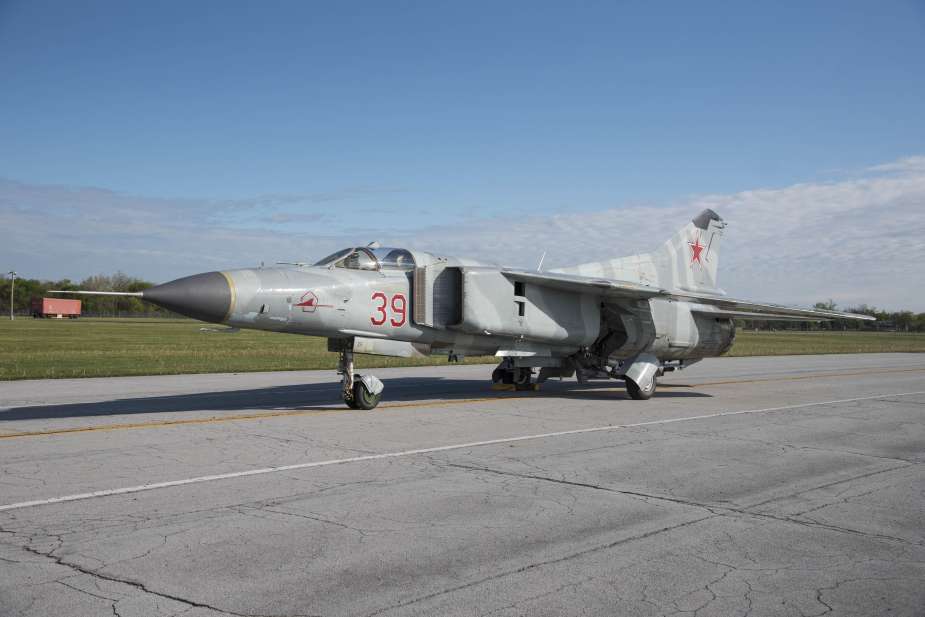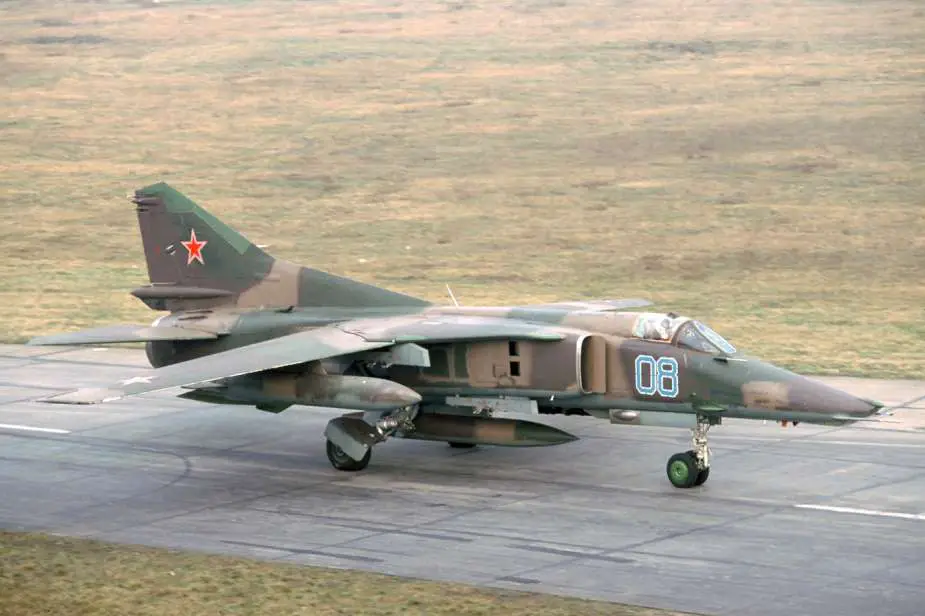Breaking news
Russia plans to develop new fighter aircraft based on MiG-23 and MiG-27 designs.
According to information published by the Russian media Kherson News on April 2, 2024, Russia is set to relaunch its military aviation capabilities with the development of a new fighter aircraft based on the iconic MiG-23 and MiG-27 aircraft. The decision comes in response to the operational insights gained from recent military engagements in Ukraine, underscoring the significant impact of high-precision weaponry on the battlefield.
Follow Army Recognition on Google News at this link

Introduced in 1969, the MiG-23, influenced by Western aircraft designs such as the F-111 and F-4 Phantom II, was a single-engine fighter capable of high maneuverability for dogfights. (Picture source: Russian social media)
The initiative aims to increase and boost the Russian Aerospace Forces with a mass-produced, easily manufactured fighter aircraft capable of deploying an increased volume of armaments. "The military operations experiences in Ukraine highlighted the critical role of high-precision weapons in advancing the front line. Thus, there's a pressing need for a fighter jet that combines ease of production with the capability to carry a substantial arsenal," citing Kherson News information.
Efforts to develop this new fighter, drawing inspiration from the Soviet-era MiG-23 and its derivative, the MiG-27, are reportedly in progress. The project seeks to blend the formidable legacy of these aircraft with contemporary systems and armaments, addressing modern warfare requirements. "We're leveraging the proven design of our Soviet fighters, the MiG-23 and MiG-27, infusing them with modern technology and weaponry. This venture is about crafting a novel aircraft that pays homage to its predecessors while being fully equipped for contemporary combat scenarios," said a member of the Russian defense industry.
Even though this information surfaced near April 1st, it remains credible. It's important to note that the Russian Army is utilizing T-54s and BTR-50s, which trace their origins back to the Second World War. Additionally, they are in the process of modernizing T-62s, preparing to deploy BTR-90 prototypes, restarting production of Tu-22 supersonic bombers, and planning to reintroduce into service an Antonov An-124 Ruslan aircraft that has been exposed to the elements for 25 years.
Introduced in 1969, the MiG-23, designed by the Mikoyan-Gurevich design bureau, represented an advancement in Soviet military aviation compared to its predecessor, the MiG-21. It featured improved avionics, better weapon systems for beyond-visual-range engagement, and variable-geometry wings for enhanced take-off and landing performance. Influenced by Western aircraft design, such as the General Dynamics F-111 and McDonnell Douglas F-4 Phantom II, the MiG-23 was a single-engine fighter capable of high maneuverability for dogfights, meeting the requirements of the Soviet Air Force. Its armament varied across models, supporting both air-to-air and ground-attack missions with a range of missiles and bombs and its 23mm cannon. With top speeds reaching up to Mach 2.35, the MiG-23 showcased high-performance capabilities. Despite not being designed for nuclear weapon delivery, its versatility in various missions made it useful in conflicts like the Iran-Iraq War, the Gulf War, and the Libyan Civil War.
The MiG-27, derived from the MiG-23, was a ground-attack aircraft introduced in 1975. It served primarily in Soviet and Warsaw Pact countries' air forces, replacing older models like the MiG-23B/BN and Sukhoi Su-7. The MiG-27 featured improvements such as better visibility from the cockpit, armor protection, and a redesigned nose. Its armament included a more powerful 30mm cannon, reflecting its focus on air-to-ground missions. Despite facing challenges like recoil from its six-barrel 30mm GSh-6-30 cannon, the MiG-27 proved reliable for low-level strike missions, although its deployment was limited by the threat from MANPADs (Man-Portable Air-Defence Systems) in theaters such as Afghanistan.

The MiG-27, derived from the MiG-23, featured improvements such as better visibility from the cockpit, armor protection, a redesigned nose, and a more powerful 30mm cannon. (Picture source: Russian social media)
Whether true or false, modernizing the MiG-23 and MiG-27 to contemporary standards would involve several key upgrades across various subsystems, focusing on enhancing combat capabilities, survivability, and performance. Based on the historical upgrades and variants of these aircraft, a comprehensive modernization program could include subsystems like avionics, armament, propulsion, electronic warfare, structural modifications, and maintenance protocols.
Incorporating advanced radar systems with better capabilities, as seen in the MiG-23P, could significantly enhance air-to-air combat efficiency. Implementing AESA (Active Electronically Scanned Array) radars would provide a significant advantage, by improving target detection, tracking, and engagement capabilities over the earlier systems like the Sapfir-23 and High Lark radar systems. A transition to a digital avionics suite, including updated flight computers, digital maps, multi-function displays (MFDs), and head-up displays (HUDs), would improve navigation, situational awareness, and mission effectiveness. For example, models like the MiG-23P featured improved radar and avionics for better interaction with ground control.
Adapting the MiG-23 and MiG-27 armament system to include a wider array of munitions, including modern air-to-air and air-to-ground weapons, precision-guided munitions, and eventually tactical nuclear weapons would significantly increase the aircraft's firepower, especially if these aircraft are modified to receive a more modern autocannon. For example, integrating laser-guided bombs and stand-off range missiles would enable the aircraft to engage targets with greater accuracy.
Improvements in engine performance and aerodynamic efficiency for better high-altitude performance, as demonstrated by the adaptations made to MiG-27s deployed in Afghanistan, are necessary to overcome operational limitations identified in varied environments. Replacing the older engines with more modern and efficient turbofan engines that offer higher thrust-to-weight ratios, reduced fuel consumption, and improved reliability should also be considered. Additionally, modernizing the airframe to reduce drag and improve maneuverability, similar to the enhancements in the MiG-23ML, would enhance the MiG-23 and MiG-27's overall combat performance in areas like speed, maneuverability, and fuel efficiency.
As seen in the MiG-23MLD variant, integrating or updating electronic warfare systems and countermeasure systems, such as chaff and flare dispensers, would be essential to improve the aircraft's survivability in contested airspace like Ukraine. Possible options could include systems similar to the BVP-50-60 flare dispensers, for defense against radar and infrared-guided missile threats, or advanced electronic countermeasures (ECM) suite to jam enemy radar and missile systems.
Improving pilot protection through armor enhancements and incorporating fire-resistant fuel tanks with an inert gas-injection system, could significantly improve the aircraft's survivability in combat situations, especially if these modernized MiG-23 and MiG-27, similar to the MiG-23B, are adapted for ground attack roles. Improving ground attack capabilities will also involve updating navigation and targeting systems, forward-looking infrared (FLIR), and laser designator, as well as autopilot functions to improve bombing accuracy for close air support missions.
Compared to the Su-34 and Su-57, these modernized MiG-23 and MiG-27 will probably simplify maintenance procedures with a modular design and introduce lifecycle management solutions for cost-effective operation and support. This also includes the development and incorporation of dedicated flight simulators and training programs to prepare pilots to make optimum use of all the implemented upgrades.























